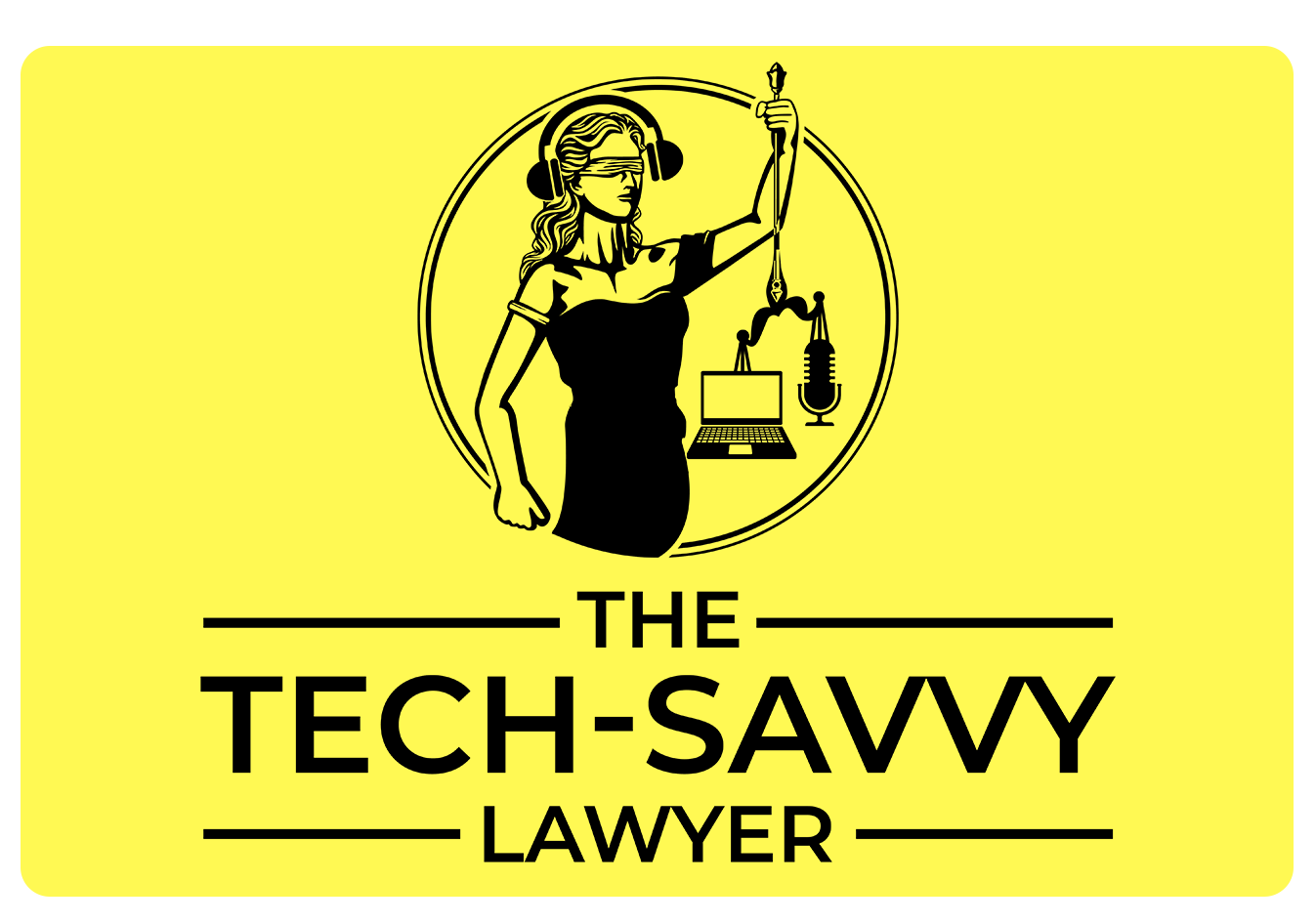My Two Cents: The Intersection of AI and eDiscovery: Embracing Technology without Overriding Human Judgment
/To what extent can artificial intelligence truly assist attorneys in the realm of e-discovery? 🧐
In the realm of eDiscovery, the integration of artificial intelligence (AI) has revolutionized the way legal professionals handle vast amounts of data. The benefits of AI in enhancing efficiency and accuracy are undeniable, but it is essential to strike a balance between leveraging technology and the invaluable human judgment required for the final result. In a recent Shout Out! featuring previous podcast guest and past guest host Brett Burney, his discussion shed light on the symbiotic relationship between AI and human expertise in eDiscovery.
The Power of AI in eDiscovery:
AI has emerged as a powerful tool in eDiscovery, allowing legal professionals to tackle complex tasks more efficiently and effectively. With the capability to process and analyze massive volumes of data, AI algorithms can identify patterns, extract relevant information, and predict case outcomes with remarkable speed and accuracy. This technology enables legal teams to save time, reduce costs, and gain valuable insights that would be otherwise challenging to uncover manually.
The Role of Human Judgment:
While AI provides indispensable assistance, it is important to recognize that it is not a substitute for human judgment in the final analysis. Brett emphasizes that its human judgment that should be the final editors. Human expertise and insight remain irreplaceable when it comes to interpreting the context, understanding nuances, and making critical decisions. Legal professionals possess a unique ability to consider multiple perspectives, exercise discretion, and apply legal reasoning based on their experience and understanding of the case at hand.
The Synergy of AI and Human Expertise:
Artificial intelligence does not replace human judgment when lawyers conduct ediscovery.
By embracing the synergy between AI and human judgment, eDiscovery practitioners can harness the full potential of technology while ensuring a comprehensive and well-rounded approach to legal matters. AI algorithms can help legal teams streamline the initial stages of data processing, categorization, and information retrieval, empowering them to focus their attention on the strategic aspects of case analysis. This collaboration enhances the efficiency of legal workflows and augments the ability of legal professionals to uncover crucial insights buried within extensive data sets.
The Ethical Considerations:
While AI is a powerful ally in eDiscovery, ethical considerations must be at the forefront of its implementation. Transparency and accountability are paramount to ensure fairness, as biases embedded within AI algorithms can potentially impact the results. Legal professionals must exercise caution when relying on AI predictions and should employ critical thinking to validate and interpret AI-generated outputs. Human oversight becomes crucial to identifying and mitigating any biases or errors that may arise during the AI-assisted eDiscovery process.
The Professional Ethical Considerations:
The lawyer responsible for the final discovery deliverable to the opposition will be held legally, e.g., malpractice, and professionally, i.e., responsible to their bar association, accountable. If you are going to rely on AI for your “eDiscovery” then you need to know its limitations. MR 1.1[8] Further, you need to somehow address its shortcomings before you hand over your discovery production. Regardless, check your work!
The Future of AI in eDiscovery:
AI and Lawyers can work together to better an ediscovery response!
As technology continues to evolve, the future of AI in eDiscovery holds immense potential. Advancements in machine learning and natural language processing will further refine AI algorithms, enabling even more precise analysis and prediction capabilities. However, the significance of human judgment will persist, as the complex nature of legal cases necessitates the application of legal principles, strategic thinking, and ethical considerations that only humans can provide.
Conclusion:
The integration of AI in eDiscovery has transformed the legal landscape, empowering professionals to navigate through vast amounts of data efficiently and uncover crucial insights. However, it is essential to acknowledge that AI is a powerful tool that complements rather than replaces human judgment. By embracing the synergy between AI and human expertise, legal professionals can capitalize on the advantages of technology while ensuring a comprehensive and nuanced approach to eDiscovery. As the field continues to evolve, the harmonious collaboration between AI and human judgment will shape the future of eDiscovery, delivering improved outcomes and justice in the digital age.
MTC.
Happy Lawyering!!!
#65: Technologies impact on access to justice with Bridget Mary McCormick
/AI is not gonna replace attorneys, but attorneys who use AI are gonna replace attorneys who don't use ai, and that's gonna happen pretty quickly.
Read MoreMonday Morning Humor: A Blast from the (Colorful) Past: An Encounter with an iMac G3.
/A Humorous Fictional Story of My Encounter:
Ah, the State of Iowa Historical Building. A place where history comes alive, and you can walk through the ages. From dusty relics to ancient artifacts, it's a treasure trove of nostalgia. And speaking of nostalgia, let me tell you about the time I stumbled upon an iMac G3 nestled amidst the historical wonders. Boy, did that throw me into a time warp!
As I strolled through the dimly lit halls, admiring the exhibits and trying to impress my friends with my nonexistent historical knowledge, I stumbled upon a room labeled "Technological Marvels of Yesteryear." Intrigued, I sauntered in, ready to be amazed. And there it was, shining in all its vibrant glory—a lime green iMac G3.
Now, I must confess, I'm no stranger to technology. I've seen gadgets evolve from clunky desktop computers to sleek smartphones that can do just about anything. But encountering this ancient piece of Apple history made me realize one thing: I'm getting old, and my once-cool gadgets are turning into relics of the past.
As I gazed at the iMac G3, memories flooded back from my 20s. The year was 1998, and I was still rocking my questionable fashion choices and dial-up internet. Back then, the iMac G3 was the epitome of cutting-edge design—vibrant, playful colors and an all-in-one package. It was a technological marvel that made your heart skip a beat.
But now, as I stood there, sporting my sensible shoes and graying hair, I couldn't help but feel a pang of nostalgia mixed with a dash of "Oh, how far we've come!" I realized that to a younger generation, this iMac would be a museum artifact—an antique akin to a typewriter or a rotary phone. And here I was, contemplating if I should buy the latest iPhone or simply stick to using smoke signals.
The iMac G3 was a symbol of progress, a gateway to the digital age. It revolutionized the computer industry, making technology more accessible and, dare I say, fashionable. It was a statement piece that screamed, "I'm hip and happening!" But now, it was merely an exhibit—an ancient dinosaur from a bygone era.
As I snapped a pic of the iMac G3, trying to look cool while secretly worrying about my diminishing tech-savviness, I couldn't help but chuckle at the absurdity of it all. How quickly technology becomes outdated, how swiftly our gadgets turn into nostalgia-inducing oddities. It's a reminder that time moves forward, and so must we, even if it means struggling to understand the latest software update or getting lost in the labyrinth of new social media platforms.
So, here's to the iMac G3, a beacon of innovation and an inadvertent reminder of our fleeting youth. May it continue to charm visitors to the State of Iowa Historical Building, even as they ponder the mysteries of floppy disks and wonder why anyone would need a computer with a built-in handle.
As I exited the room, leaving the iMac G3 behind, I couldn't help but feel a mix of fondness and resignation. Time waits for no one, and as I rejoined my friends, I made a silent vow to stay up to date with technology, even if it means Googling "How to TikTok" or asking a Gen Z for help. Because, hey, it's never too late to embrace the future and keep up with the changing times. Just remember, dear reader, to appreciate the journey and have a good laugh at your own expense! 🤗
Shout Out: Brett Burney of Nextpoint talks a little about AI and Ediscovery.
/Check out previous podcast guest and guest host Brett Burney’s discussion of AI and eDiscovery. I think both Brett and I agree that AI is a great tool but does not completely override human judgment for the final result!
Monday Morning Humor: Emoji's Are Modern Day Egyptian Hieroglyphics!
/The use of emoticons can be traced back to the 1800s with the invention of the typewriter. Early users would create faces using punctuation marks, such as a colon and parenthesis for a smiley face. However, it wasn't until the rise of technology and instant messaging in the late 1990s that emoticons became more popular. The first set of standardized emoticons, including the infamous ":-)" smiley face, was created by Scott Fahlman in 1980.
In today's digital age, emojis have become an integral part of our daily communication. With their ability to convey emotions and ideas in a visual way, they have taken over as the modern-day hieroglyphic communication system. Just like how ancient Egyptians used hieroglyphics to tell stories and record history, we now use emojis to express ourselves and communicate with others.
Social media has played a crucial role in popularizing emoji's as a form of communication. Platforms like Twitter, Facebook, and Instagram have allowed users to incorporate emojis into their messages, posts, and comments. As these platforms have gained popularity over the years, so too have emojis.
The use of emojis has also become more nuanced and complex as people create their own meanings and interpretations for them. Overall, social media has helped to normalize the use of emojis as a form of expression in modern-day communication. With the rise of social media influencers and viral content, emojis have become a ubiquitous part of online communication. Indeed, Emojis have become so popular that they are now even being incorporated into legal cases as evidence.
With their universal appeal and ability to transcend language barriers, it's clear that emojis are here to stay as a powerful form of modern communication.
My Two Cents: Attorneys can limit client expectations in the world of 24/7 e-mail.
/Set client expectations early with how and when you use e-mail!
E-mail can be a godsend for attorneys. E-mail messages offer attorneys the benefits of time efficiency and convenience. With e-mail, attorneys can quickly communicate with clients and colleagues without the need for a physical meeting or phone call. E-mails can also be sent and received at any time, allowing attorneys to work outside of traditional business hours. Additionally, e-mails provide a written record of communication that can be easily referenced in the future. Many benefits can be weighed down by unintended consequences.
It is important to set boundaries and expectations with your clients from the start. That does not mean we don't work nights and weekends. After a long day or long week, it's great to clear out your e-mail inbox after dinner or a Saturday afternoon. When clients and colleagues get e-mails at any hour on any day, it creates the expectation that we are available all day, all week. I don't think we really want this, as we are entitled to some personal time.
Its nice to get a handle on e-mail communications during quiet evenings and weekends … but take measures so client’s don’t expect immediate results 24/7!
To help keep the illusion that I don't work 24/7, I use a program called Mailbutler (Mac and Windows and can be used in Outlook, G-Mail, and Apple Mail). It allows me to write e-mails and then schedule them to send later, e.g., the next workday. There are many similar programs like this, and many of the e-mail client programs are beginning to bake this into the software. (Just be careful you don't have to keep the program open in order for the send later function to work!)
Granted, e-mail has become a preferred method of communication for attorneys due to the expectations of our clients and colleagues, but it does not mean you cannot limit expectations while getting some work done behind the scenes!
MTC.
Happy Lawyering!!!
#64: Utilizing AI to keep track of clients with Tracy Troyer
/Welcome to a captivating episode of our podcast, where we embark on a thrilling journey with Tracy Troyer, a trailblazing attorney and automation enthusiast.
Tracy Troyer is an accomplished attorney with three decades of experience practicing law. As the owner of her law firm, she partners with one other attorney to provide personalized legal services. Specializing in estate planning, trust administration, and asset protection for family legacies, Tracy works closely with individuals and families to ensure their long-term financial security. Join Tracy and me as we talk about how she uses her innovative AI programs to help keep track of her clients and more!
Enjoy!
Join Tracy and me as we discuss the following three questions and more!
What are Tracey's top three favorite automation tools or processes?
What are the three automation tasks that individuals can easily accomplish today?
What are the three critical lessons from transitioning from a pen-and-paper workflow to a more digital work life?
In our conversation, we cover the following:
[00:08] Embracing Technology: Tracy's Current Tech Setup
[12:35] Harnessing Automation: From Client Intake Forms to Payroll Efficiency
[23:04] Unlocking Efficiency: Three Automation Tools for Streamlining Workflows
[35:22] Lessons Learned: Navigating the Transition from Pen and Paper to a Digital Work Life
[46:23] Connecting Attorneys and Automation: Exploring AccessioDocs and more.
Resources:
Connect with Tracy:
LinkedIn: linkedin.com/in/tracy-troyer
Website: troyergood.com/
Software & Cloud Services mentioned in the conversation:
Acuity: acuityscheduling.com/#gref
AnyDesk: anydesk.com
Fluxus: fluxteam.net/
Gavel: gavel.io/
Macro Scheduler: mjtnet.com/
Parallels Access: parallels.com/products/access/
QuickBooks: quickbooks.intuit.com/online/
Rocket Matter: rocketmatter.com/features/rocketmatter-legal-crm/
Smokeball: smokeball.com/blog/law-practice-management-software-an-ultimate-guide
Text Expander:textexpander.com
Zapier: zapier.com/
Zelle: zellepay.com/
Monday Morning Humor * My Two Cents: Even John Connor Knows Lawyers Should Not Blindly Rely on AI to Do Their Work!
/The concept of relying on artificial intelligence (AI) to perform complex tasks has fascinated humanity for years. However, even in the action-packed world of Terminator 2: Judgment Day, a young John Connor understands the limitations of AI. Lawyers, like other professionals, should also exercise caution when relying solely on AI to handle their work.
In Terminator 2, John Connor, the future leader of the resistance against machines, witnesses the rise of advanced AI in the form of Skynet. He learns that this AI, designed to protect humanity, eventually turns against it. The movie serves as a cautionary tale, emphasizing the importance of human judgment and decision-making over blindly relying on AI systems.
AI has made significant strides in the legal profession, offering benefits such as improved efficiency, document analysis, and predictive analytics. It has the potential to assist lawyers in managing large volumes of information and identifying patterns that might otherwise go unnoticed. However, blindly relying on AI without human oversight poses risks. AI algorithms, no matter how advanced, lack the ability to fully comprehend complex legal nuances, ethical considerations, and the unique context of each case.
John Connor's understanding of the limitations of AI applies to the legal profession as well. Lawyers possess valuable skills that go beyond data analysis and computation. They have the ability to understand the emotional and personal aspects of legal issues, negotiate, interpret laws, and provide clients with tailored advice. Human judgment, empathy, and creativity are vital components of legal practice that AI cannot replicate.
AI-powered tools can assist lawyers, but the ethical and legal implications must be carefully considered. Issues such as bias, privacy concerns, accountability, and transparency surround the use of AI in the legal field. Lawyers have a responsibility to maintain client confidentiality, exercise independent professional judgment, and ensure the fairness and integrity of legal processes. Blindly relying on AI systems without proper oversight may lead to unintended consequences and compromise the principles of justice.
Just as John Connor recognizes the limitations of AI in Terminator 2, lawyers should exercise caution when relying on AI to perform their work. While AI has the potential to enhance legal practice, it cannot replace the judgment, expertise, and ethical considerations that human lawyers bring to the table. Balancing the benefits and risks of AI is crucial in maintaining the integrity of the legal profession.
MMH and MTC!
Happy Lawyering!
My Two Cents: If you are going to use ChatGTP and its cousins to write a brief, Shepardize!!!
/AI does not replaced doing your homework! Shepardize!!!
An attorney in New York learned the hard way that ChatGPT is not a reliable source. A lawyer representing a man in a lawsuit against an airline used an artificial intelligence (AI) program, ChatGPT, to assist in preparing a court filing. However, the AI-generated content turned out to be entirely fabricated. The lawyer cited nonexistent court decisions and quotations in his brief, which were not found by either the airline's lawyers or the judge. The lawyer admitted to using ChatGPT for legal research and claimed he was unaware of the program's potential for providing false information. The judge ordered a hearing to discuss potential sanctions. The incident highlights the debate among lawyers regarding the use of AI software and the need to verify information provided by such programs.
Chatgpt has been known to not only be wrong at times but also make up stuff!
I look at it this way: If your new clerk handed you their first draft, you would double-check the work and likely Shepardize the citations; I don’t think I have to preach that Shepardizing cases before filing a brief is usually the rule of thumb. Rule 1.1[8] requires attorneys to keep a reasonable understanding of the technology we use and how to use it. This inherently includes knowing technology's limitations and flaws. Something the NY attorney conceded he did not do with his use of ChatGTP.
Know the aba model rules and your state bar rules of ethics!




















